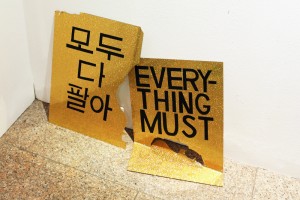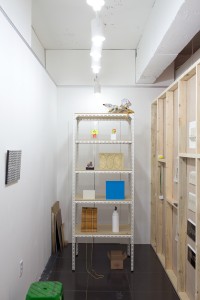



2014.5.21 – 2014.6.16
: Stock’s Room 스톡스 룸
: Paul Kajander, 폴 카잔더
: 2014년 5월 21일 ~ 2014년 6월 16일 오후 6 -9시
: 전시정보/전시서문:
스톡스 룸 Stock’s Room <한문>
하나와 하나, 둘로 구성된 전체, 젊은이의 팔에 달린 늙은이의 손**
진열장과 창고는 두 개로 나누어진 하나의 단일 공간이다. 두 공간은 서로의 존재를 한 공간에서 다른 공간으로 이동하는 물건들을 통해 인지한다. 스니커즈를 예로 들어보자. 미술계는 부드럽고 흡수성이 좋은 재질 구성과 색감에 있어 알 수 없는 단계에 다다른 스니커즈를 환영한다. 스니커즈는 실용적인 스타일을 제안하는 대표적인 존재이고, 오늘날 삶 전반에 있어 이러한 미학을 상징하는 조형물과도 같이 때문이다. 네이비 수트의 끝 단이 스니커즈의 청록색 메시 위에 차분히 놓여진다. 사람들은 거리에서 스니커즈의 자태를 훔쳐본다. 스니커즈는 안 쪽에 종이 뭉치를 넣고서는 신선한 고무 냄새를 풍기며 어두컴컴한 창고에서 소환한다. 스니커즈는 가게에서 거리로 나선다. 스니커즈가 가지고 있던 소위 완벽함은 빠르게 사라진다. 결핍이 스니커즈의 끈을 단단히 묶는다. 스니커즈는 거리를 걸으며, 자신의 몸에 먼지를 묻힌다. 윈래의 형광색 빛깔은 곧 바래진다. 허탈한 기분이다. 이런 신발을 신을 때, 신발을 닳을 수 밖에 없다는 불가피한 사실에 항복해야 한다는 건 유쾌한 일이 아니다. 신발들은 급속도로 낡는다. 스니커즈의 밑창은 원래 거리의 더러움과 만날 것이 아니었다. 스니커즈의 세상에는 지저분한 거리라던가 막힌 하수구에 고인 물에 노란 빨대들이 둥둥 떠다니는 광경 같은 건 존재한지 않는다.
이성적인, 매끈한, 온전한, 제공 가능한, 진열창, 어두컴컴한, 은밀한, 재촉하는, 숨겨진. 스톡스 룸 한 공간은 거리의 존재를 통해 앞과 뒤고 구분된다. 시장의 흐름은 변하기 마련이다. 사람들은 물건들을 입고, 사용한다. 그리고 이런 사용 감이 너무 드러나는 순간사람들은 물건들을 거리로 내보낸다. 물건들은 거리에 누워있는 자신의 상태가 혼란스럽다. 잘못된 장서에 있어서가 아니라 폐기되었기 때문이다. 우리는 이제 쓸모 없어. 더 이상 욕망의 대상이 아냐. 모든 물건들은 언젠가는 폐물이 되기 마련이다. 신발을 신발 박스 안에 보관하는 등 인간이 아무리 노력을 해도 이는 필연적이다. 신발 박스 안 포장지에 감싸여서 새로움을 되찾으려고 노력해도, 고리에서 묻혀 온 때들은 포장지에 미세하게 조금씩 조금씩 계속 묻어나갈 것이다. 신발의 밑창 또한 발가락 부분부터 휘어지기 시작하여 최초의 상태를 배신한다. 처음의 새로움은 절대 다시 회복할 수 없다. 그 곳은 이제 존재하지 않는다.
재활용품으로 분류되면 새로운 제품으로 다시 태어날 수도 있을 테지만, 거리에 버려진 물건들은 행정 원칙상 재활용품으로 분류되지도 않는다. 거리에 던져진 물건들은 그나마 쓰레기통에 들어가지도 못했다. 쓰레기라고 할 수도 없고 재활용으로 구원받지도 못 하는 이 물건들은 그들만의 새로운 범주를 만들어낸다. 조형물의 일부분이 될 때, 물건들은 그들의 운명에서 벗어난다. 이러한 물건들의 이동에는 슬픈 울음 소리를 잠재우고, 적막한 잠을 깨우는, 일종의 위안이 존재한다. 이동에 있어 꼭 무언가를 참조해야 하는 건 아니다. 물건들은 자신의 태생과 근원으로부터 해방되었다. 그들을 이 혼란스러운 먼지 구덩이로부터 벗어나기 위해 자신들 같은 존재들과 얽히고 뒤섞일 방법을 찾아 나선다.
** 주나 반스의 1936년 작 <나잇트우드>에 실린 로빈 보트에 대한 묘사 주해
앤 로우는 런던 왕립 대학교 대학원에서 현대미술 큐레이팅 예술석사학위를 수여 받았다. 현재 벤쿠버 카트리오나 제프리 갤러리에서 디렉터로 활동 중이다.
스톡스 룸 Stock’s Room <영문>
One and one, all being composed of two
A hand which looks remarkably old yet is attached to the arm of a young person**
The store front and the stock room: a single entity composed of two parts, which only know of one another’s existence through the passage of objects from one space to the other. For example, the sneakers of today. Having reached unknown heights of spongy fabrication and hue, the art would like them because they have become like sculptures twinned with comforts which suggest a lackadaisical flair for aesthetics in all aspects of life. The sharp cuff of a navy suit calmly rests atop turquoise mesh. They are spied from the street, then summoned from the stock room, off-gassing and fresh, with balled up tissue jammed in the toe. They leave the store. Their alleged wholeness is quickly whipped away, their lack ties the laces and they walk, slaking, dirt and making fluorescents grubby. This feeling is generally a let-down, there isn’t much pleasure in giving over to this inevitability of wear with these sorts of shoes. They become old in an accelerate way, the colours of their caterpillar soles were not meant to meet the dirt of the street. But in the universe of these sneakers, there is no such thing as a dirty old street or a clogged sewer with a yellow drinking straw bathing in the un-drained water.
Rational, smooth, whole, available. The Store Front.
Darkened, clandestine, urging, hidden. The Stock’s room
The presence of the street dictates a spatial arrangement, a front and back. The flow of a market ebbs, objects are cast forth onto bodies or used by bodies and when they show too much of this use, onto the street they go. They lie around confused as they have not been mislaid, but rather they have been discarded. No longer of use, no longer of desire.
At one time or another every object gains the patina of junk, despite all our best efforts to store shoes in shoeboxes, there will always be a thin layer of grime gently brushing the tissue paper attempting to reclaim their newness. The soles take on a defiant curve, raised annoyingly at the toe. Their original surfaces can never be repatriated, the place where they came from doesn’t exists anymore.
The object that have made it onto the street lack a quality that would organize them within the civic principles of what can be recycled, a process which manufactures ostensibly new objects that will themselves later be reconstituted into other forms of manufactured objects. This, or they have just, missed the bin when they were tossed out the front door. It’s an entirely supplementary category, to be neither garbage nor salvageable. When they become part of sculpture however, they are pulled out of that flow. There is comfort in this removal, it quits the sad bleating of some and wakes the silent repose of others. The terms of these materials aren’t necessarily referential, they’ve been unburdened from their origins and seek to be entwined with others of their kind if only they could be plucked from the dust.
** To paraphrase Djuna Barnes in her description of Robin Vote in her 1936 book ‘Nightwood’. Anne Low received an MA in curating Contemporary Art from the Royal College of Art, London and is currently Director of Catrina Jeffries Gallery, Vancouver.